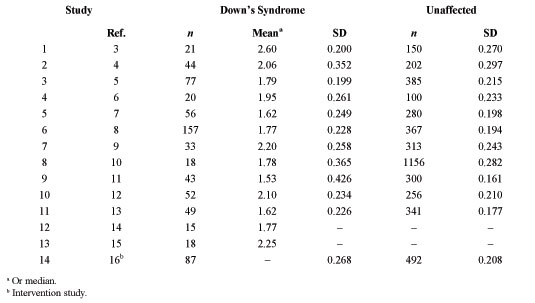


UPDATED MODELING PARAMETERS FOR
DOWN’S SYNDROME SCREENING
Cuckle HS*
*Corresponding Author: Professor Howard S. Cuckle, Reproductive Epidemiology, University of Leeds, 3 Gemini Park, Sheepscar Way, Leeds LS7 3JB, North Yorkshire, UK; Tel.: +44-113-284-9230; Fax: +44-113-262-1658; E-mail: h.s.cuckle@leeds.ac.uk
page: 101
|
|
RESULTS
Table 1 shows for each individual publication the DS mean for second trimester inhibin and the log10 SD in both affected and unaffected pregnancies. The overall DS mean based on 603 pregnancies is 1.85 MoM with 95% confidence interval (CI) 1.74-1.96 MoM. The overall difference in variance between affected and unaffected pregnancies is 0.0252.
Most of these studies did not report data that could be used to calculate covariances, so direct estimates of the R-values were used instead. Table 2 shows the available individual estimates; the weighted mean values in DS and unaffected pregnancies were: free-β hCG 0.37 and 0.32; hCG 0.44 and 0.38; AFP 0.08 and 0.16; uE3 –0.13 and 0.01.
Similarly, there was insufficient data to estimate the difference in covariance for first trimester PAPP-A and second trimester serum markers. Table 3 shows the the available individual estimates; there was only one estimate for DS pregnancies and the weighted mean values in unaffected pregnancies were: free-β hCG 0.14, hCG 0.12, AFP 0.06, uE3 0.16 and inhibin 0.07.
Table 4 shows for each NT publication the DS mean and the log10 SD in DS and unaffected pregnancies. The overall DS mean based on 703 pregnancies is 2.03 MoM (95% CI 1.93-2.14 MoM). The overall difference in variance between affected and unaffected pregnancies is 0.0419. No correlation with serum markers has been found in any study.
The parameters for the individual NF studies are also shown in Table 4. The DS mean based on 234 pregnancies is 1.45 MoM (95% CI 1.34-1.57 MoM). The unaffected variance was only available for one study, so the DS SD was estimated directly as 0.2067. No consistent correlation was found with serum markers except for second trimester hCG in DS pregnancies. Since two of the studies found a strong association [34,35], the mean value of 0.37 was used for both hCG and or free-β hCG, which had not been tested in any of the studies.
Table 5 shows model predicted screening performance for different marker combinations. The addition of inhibin to three marker second trimester serum screening policies increases the detection rate for a 5% FPR by about 6%. Ultrasound NT alone at 11-13 weeks has a DR about 4% higher than the best second trimester serum only combination. The addition to NT to first trimester serum combinations of two and four markers at 10 and 13 weeks increases detection by about 12-14%. A similar increase was found at 11 and 12 weeks (not shown). The NF is a poorer marker than NT but it’s use in addition to the best four marker second trimester serum screening combination increases detection by 10%. Adding first trimester PAPP-A at 10 and 13 weeks to second trimester serum screening increases detection by about 4-9%. The addition of NT to this two sample policy increases detection by 13-16%, about 1-3% higher than the best first trimester NT combination. The addition of NF to the best second trimester serum screening policy increases detection by about 7-9%.

Table 1. Second trimester inhibin: means (MoM) and standard deviations (SD) (log10 MoM)
|
|
|
|



 |
Number 27
VOL. 27 (2), 2024 |
Number 27
VOL. 27 (1), 2024 |
Number 26
Number 26 VOL. 26(2), 2023 All in one |
Number 26
VOL. 26(2), 2023 |
Number 26
VOL. 26, 2023 Supplement |
Number 26
VOL. 26(1), 2023 |
Number 25
VOL. 25(2), 2022 |
Number 25
VOL. 25 (1), 2022 |
Number 24
VOL. 24(2), 2021 |
Number 24
VOL. 24(1), 2021 |
Number 23
VOL. 23(2), 2020 |
Number 22
VOL. 22(2), 2019 |
Number 22
VOL. 22(1), 2019 |
Number 22
VOL. 22, 2019 Supplement |
Number 21
VOL. 21(2), 2018 |
Number 21
VOL. 21 (1), 2018 |
Number 21
VOL. 21, 2018 Supplement |
Number 20
VOL. 20 (2), 2017 |
Number 20
VOL. 20 (1), 2017 |
Number 19
VOL. 19 (2), 2016 |
Number 19
VOL. 19 (1), 2016 |
Number 18
VOL. 18 (2), 2015 |
Number 18
VOL. 18 (1), 2015 |
Number 17
VOL. 17 (2), 2014 |
Number 17
VOL. 17 (1), 2014 |
Number 16
VOL. 16 (2), 2013 |
Number 16
VOL. 16 (1), 2013 |
Number 15
VOL. 15 (2), 2012 |
Number 15
VOL. 15, 2012 Supplement |
Number 15
Vol. 15 (1), 2012 |
Number 14
14 - Vol. 14 (2), 2011 |
Number 14
The 9th Balkan Congress of Medical Genetics |
Number 14
14 - Vol. 14 (1), 2011 |
Number 13
Vol. 13 (2), 2010 |
Number 13
Vol.13 (1), 2010 |
Number 12
Vol.12 (2), 2009 |
Number 12
Vol.12 (1), 2009 |
Number 11
Vol.11 (2),2008 |
Number 11
Vol.11 (1),2008 |
Number 10
Vol.10 (2), 2007 |
Number 10
10 (1),2007 |
Number 9
1&2, 2006 |
Number 9
3&4, 2006 |
Number 8
1&2, 2005 |
Number 8
3&4, 2004 |
Number 7
1&2, 2004 |
Number 6
3&4, 2003 |
Number 6
1&2, 2003 |
Number 5
3&4, 2002 |
Number 5
1&2, 2002 |
Number 4
Vol.3 (4), 2000 |
Number 4
Vol.2 (4), 1999 |
Number 4
Vol.1 (4), 1998 |
Number 4
3&4, 2001 |
Number 4
1&2, 2001 |
Number 3
Vol.3 (3), 2000 |
Number 3
Vol.2 (3), 1999 |
Number 3
Vol.1 (3), 1998 |
Number 2
Vol.3(2), 2000 |
Number 2
Vol.1 (2), 1998 |
Number 2
Vol.2 (2), 1999 |
Number 1
Vol.3 (1), 2000 |
Number 1
Vol.2 (1), 1999 |
Number 1
Vol.1 (1), 1998 |
|
|

